Topics on this page

Regular Exams and Cleanings
Regular exams are an important part of maintaining your oral health. During your appointment, we will:
- Examine your entire mouth and check for any areas of concern
- Look for cavities or any other signs of tooth decay or wear
- Assess your teeth and gums for gingivitis and signs of periodontal disease
- Perform a thorough teeth cleaning to remove any tartar and plaque that have built up on the surface of the teeth or below the gumline
This appointment is typically scheduled for 60 minutes. Visiting our office every six months gives you the chance to ask the doctors any questions you may have about your oral health.
Bonding
 Bonding is a conservative way to repair slightly chipped, discolored, or crooked teeth. During dental bonding, a white filling is placed onto your tooth to improve its appearance. The filling “bonds” with your tooth, and because it comes in a variety of tooth-colored shades, it closely matches the appearance of your natural teeth.
Bonding is a conservative way to repair slightly chipped, discolored, or crooked teeth. During dental bonding, a white filling is placed onto your tooth to improve its appearance. The filling “bonds” with your tooth, and because it comes in a variety of tooth-colored shades, it closely matches the appearance of your natural teeth.
Bonding is less expensive than other cosmetic treatments (such as porcelain veneers) and can usually be completed in one visit to our office.
Bridges
 A bridge may be used to replace missing teeth, help maintain lip and cheek support, or alleviate stress on your bite.
A bridge may be used to replace missing teeth, help maintain lip and cheek support, or alleviate stress on your bite.
A bridge replaces missing teeth with artificial teeth by literally bridging the gap where one or more teeth may have been. Your bridge can be made from gold, alloys, or porcelain and is bonded onto surrounding teeth for support.
The success of any bridge depends on its foundation. Therefore, it’s vital to keep your existing teeth, gums, and jaw healthy.
Crowns
 Crowns are a restorative procedure used to improve your tooth’s shape or strengthen it. Crowns are most often used for teeth that are broken, worn, or have large portions destroyed by tooth decay.
Crowns are a restorative procedure used to improve your tooth’s shape or strengthen it. Crowns are most often used for teeth that are broken, worn, or have large portions destroyed by tooth decay.
A crown is a “cap” cemented onto an existing tooth that usually covers the portion of your tooth above the gum line. In effect, the crown becomes your tooth’s new outer surface. Crowns can be made of porcelain or gold. Porcelain crowns are most often preferred because they mimic the color and translucency of natural teeth and are very strong.
Crowns or onlays (partial crowns) are needed when there is insufficient tooth strength to hold a filling. Your crown is created in a lab from your unique tooth impression, which allows a dental laboratory technician to examine all aspects of your bite and jaw movements.
Your crown is designed just for you so your bite and jaw movements function normally once the crown is placed. In some instances, we are able to fabricate your crown in-office using CEREC® same day crown technology.
Dentures
 Dentures are natural-looking replacement teeth that are removable. There are two types of dentures: full and partial. Full dentures are given to patients when all the natural teeth have been removed.
Dentures are natural-looking replacement teeth that are removable. There are two types of dentures: full and partial. Full dentures are given to patients when all the natural teeth have been removed.
Partial dentures are attached to a metal frame that is connected to your natural teeth and are used to fill in where permanent teeth have been removed.
Please explore our Dental Implants page to learn more about how your dentures can be attached to dental implants for additional support and stability.
Extractions
 There are times when it is necessary to remove a tooth. Sometimes a baby tooth has misshapen or long roots that prevent it from falling out as it should and the tooth must be removed to make way for the permanent tooth to erupt.
There are times when it is necessary to remove a tooth. Sometimes a baby tooth has misshapen or long roots that prevent it from falling out as it should and the tooth must be removed to make way for the permanent tooth to erupt.
At other times, a tooth may have so much decay that there is not enough remaining tooth structure to predictably restore it, so our doctors may recommend removal and replacement with a bridge or implant. Infection, orthodontic correction, or problems with a wisdom tooth can also require removal of a tooth.
Once a tooth has been removed, neighboring teeth may shift, potentially causing problems with chewing, tooth alignment, or jaw joint function. To avoid these complications, we may recommend that you replace the extracted tooth with a dental implant, bridge, or partial denture.
Fillings
 Dental restorations, or fillings, are are used to replace missing tooth structure that has been lost to decay or fracture of the tooth. There are a wide variety of dental materials available to restore teeth, including composite resins, glass ionomers, ceramics, and amalgam.
Dental restorations, or fillings, are are used to replace missing tooth structure that has been lost to decay or fracture of the tooth. There are a wide variety of dental materials available to restore teeth, including composite resins, glass ionomers, ceramics, and amalgam.
With the advances in dental adhesives and materials, tooth-colored composite resin is typically the material of choice because it is aesthetic and has a great track record for clinical success.
Fluoride
 Fluoride is effective in preventing cavities and tooth decay. A fluoride treatment in our office takes just a few minutes.
Fluoride is effective in preventing cavities and tooth decay. A fluoride treatment in our office takes just a few minutes.
After the treatment, patients may be asked not to rinse, eat, or drink for at least 30 minutes in order to allow the teeth to absorb the fluoride. Depending on your oral health or our recommendation, you may have a fluoride treatment every three, six, or 12 months.
Dental Implants
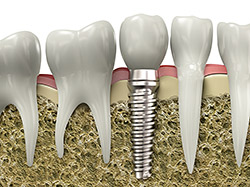 A dental implant is an excellent way to replace a missing tooth or multiple teeth. A dental implant is a titanium post that is placed in the jaw bone to replace the root of your tooth.
A dental implant is an excellent way to replace a missing tooth or multiple teeth. A dental implant is a titanium post that is placed in the jaw bone to replace the root of your tooth.
Several options exist to restore teeth using dental implants, ranging from single crowns to implant-supported dentures. Be sure to look at our Dental Implants page for more information about this treatment option.
Mouthguards
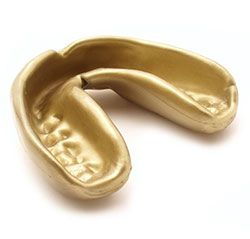 Whether you wear braces or not, protecting your smile while playing sports is essential. Mouthguards help protect your teeth and gums from injury. If you participate in any kind of full-contact sport, the American Dental Association recommends that you wear a mouthguard.
Whether you wear braces or not, protecting your smile while playing sports is essential. Mouthguards help protect your teeth and gums from injury. If you participate in any kind of full-contact sport, the American Dental Association recommends that you wear a mouthguard.
There are three basic types of mouthguards: the pre-made mouthguard, the “boil-and-bite” fitted mouthguard, and a custom-made mouthguard from a dentist. When you choose a mouthguard, be sure to pick one that is tear-resistant, comfortable and well-fitted for your mouth, easy to keep clean, and does not prevent you from breathing properly. We can help you choose the right mouthguard to protect your smile.
Nightguards
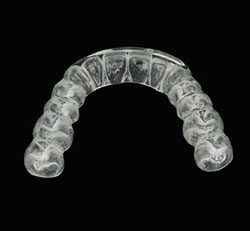 If you often wake up with jaw pain, earaches, or headaches, or find yourself clenching or grinding your teeth, you may have a common condition called “bruxism.” Many people do not even know they grind their teeth, because it often occurs when one is sleeping. If not corrected, bruxism can lead to broken teeth, cracked teeth, and even tooth loss.
If you often wake up with jaw pain, earaches, or headaches, or find yourself clenching or grinding your teeth, you may have a common condition called “bruxism.” Many people do not even know they grind their teeth, because it often occurs when one is sleeping. If not corrected, bruxism can lead to broken teeth, cracked teeth, and even tooth loss.
There is an easy, non-invasive treatment for bruxism. Nightguards are an way to prevent the wear and damage that teeth-grinding causes over time. Custom-made by our office, a nightguard is inserted over your top or bottom arch and prevents contact with the opposing teeth.
Root Canals
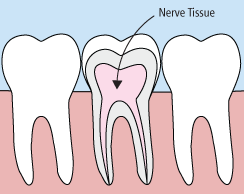 When a tooth is cracked or has a deep cavity, bacteria can enter the pulp tissue and germs can cause an infection inside the tooth. If left untreated, an abscess may form.
When a tooth is cracked or has a deep cavity, bacteria can enter the pulp tissue and germs can cause an infection inside the tooth. If left untreated, an abscess may form.
If the infected tissue is not removed, pain and swelling can result. This can not only injure your jawbones, but it is also detrimental to your overall health.
During root canal treatment, a general dentist or endodontist (a dentist who specializes in problems with the nerves of the teeth) removes the affected tissue. Next, the interior of the tooth will be cleaned and sealed.
Finally, the tooth is filled with a dental composite. If your tooth has extensive decay, we may suggest placing a crown to strengthen and protect it from breaking.
Sealants
 Sometimes brushing is not enough, especially when it comes to those hard-to-reach spots in your mouth. It is difficult for your toothbrush to get between the small cracks and grooves on your teeth. If left alone, those tiny areas can develop tooth decay.
Sometimes brushing is not enough, especially when it comes to those hard-to-reach spots in your mouth. It is difficult for your toothbrush to get between the small cracks and grooves on your teeth. If left alone, those tiny areas can develop tooth decay.
Dental sealants are plastic resins that are bonded in the deep grooves on your tooth’s surface. When a tooth is sealed, the tiny grooves become smooth and are less likely to harbor plaque. With sealants, brushing your teeth becomes easier and more effective against tooth decay.
Sealants are typically applied to children’s teeth as a preventive measure against tooth decay after the permanent teeth have erupted. However, adults can also receive sealants on healthy teeth.
It is more common to seal “permanent” teeth rather than “baby” teeth, but every patient has unique needs, and we will recommend sealants on a case-by-case basis.
Sealants last from three to five years, but it is fairly common to see adults with sealants still intact from their childhood.
Veneers
 You no longer need to hide your smile because of gaps, chips, stains, or misshapen teeth. With veneers, you can easily correct your teeth’s imperfections to help you have a more confident, beautiful smile. Veneers are natural in appearance, and a perfect option for patients who want to make adjustments to the look and feel of their smile.
You no longer need to hide your smile because of gaps, chips, stains, or misshapen teeth. With veneers, you can easily correct your teeth’s imperfections to help you have a more confident, beautiful smile. Veneers are natural in appearance, and a perfect option for patients who want to make adjustments to the look and feel of their smile.
Veneers are thin, custom-made shells made from tooth-colored porcelain that are designed to cover the front side of your teeth. Your doctor may need to conservatively prepare your tooth to achieve the desired aesthetic result. When your veneers are placed, you’ll be pleased to see that they look like natural teeth.
Wisdom Teeth
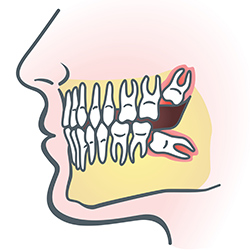 Wisdom teeth are molars found in the very back of your mouth. They usually appear in the late teens or early twenties, but may become impacted (fail to erupt) due to lack of room in the jaw or the angulation of the teeth.
Wisdom teeth are molars found in the very back of your mouth. They usually appear in the late teens or early twenties, but may become impacted (fail to erupt) due to lack of room in the jaw or the angulation of the teeth.
Wisdom teeth are typically removed in the late teens or early twenties because there is a greater chance that the roots have not fully formed and the bone surrounding the teeth is less dense. These two factors can make extraction easier as well as shorten the recovery time.
If wisdom teeth are not removed, they tend to be difficult to clean due to the position of the teeth and you may develop gum tenderness or tooth pain.

